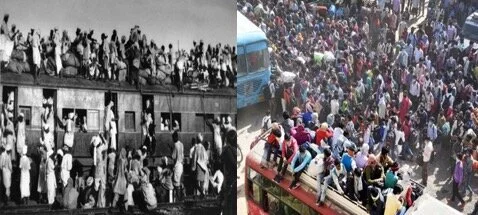1947 All Over Again
Ishaan Shah, Print Staff Writer
September 7 2020
History has a tendency to repeat itself. The similarity in the two images above, despite occurring 73 years apart, is uncanny but also dangerous. The one on the left is during the independence partition between India and Pakistan in 1947 while the one on the right is the migrant crisis of 2020 after the COVID-19 lockdown imposed by the Modi government. It came into power in 2014 with a lot of promises, with the slogan ‘Sabka Saath, Sabka Vikas’, which meant ‘collective effort, inclusive growth’, which would apparently bring ‘Ache Din’ (good days) to India. It promised a lot of things to the Indian people, including eradication of corruption, lower unemployment, and housing for everyone by 2022 . It has failed on these promises and has failed the people. This failure has been captured by the government’s response to the COVID-19 pandemic.
On March 24th, Prime Minister Narendra Modi imposed a nationwide lockdown along with a ban on inter-state travel that took effect from midnight on the 25th. As India received applause from the WHO for its strict lockdown measures, migrant workers in search of a better life from diverse parts of the country such as (rural area) to Mumbai and Delhi were left in limbo by the Indian government. Indians received a four hour notice before a lockdown was imposed. This had no effect on the rich in their sprawling, suburban homes and apartments in the city but the migrant workers had to find a way home. They did not have enough food or money to survive in the bustling metropolitan cities, nor did they have any transportation to go back. Hence, they decided to walk.
According to the 2011 Indian Census, there are 450 million migrants, a significant figure which includes inter-state, intra-state and foreign migrants. There was not a single consideration made for them by the Modi government while making the lockdown decision. The effects are starting to be seen now. As of June 3, there have been 198 migrant deaths, the leading cause of death being suicide. To try and help these migrants, PM Modi first released a US$ 22 billion care package, along with a larger one claimed to be worth 10% of the GDP (US$ 200 billion, INR 20 lakh crore) However, upon investigation by analysts, the direct fiscal impact of the reforms comes to around Rs 2 lakh crore (1% of GDP). Fitch Solutions reports that “India’s package includes previously announced measures and also monetary stimulus, making the actual fiscal impact of the additional stimulus only about 1% of GDP, according to our estimates.”
This package did not provide any assistance to aid the migrant workers in their journey home. Firstly, it gave them an additional income of just Rs. 2000 (~US$ 29) by increasing the wage rate for rural workers under the Mahatma Gandhi Employment Guarantee Act. Secondly, women with Jan Dhan accounts, a financial inclusion program of the Government of India open to Indian citizens, received Rs. 500 (~US$ 7) a month for three months. Finally, senior citizens, widows, disabled individuals received Rs. 1,000 (~US$ 14) in two instalments over 3 months. All of this can barely cover a week’s food and home expenditure, along with transportation costs to get home through the special trains that the government started later. As of May 2019, 356 million people have a bank account under the Jan Dhan scheme, but 52% of these users still prefer to keep their savings at home, with just 11% having good financial literacy (defined as knowing how to operate a bank account, along with strong financial attitude and behaviour). Hence, most people covered under the relief package will not receive even the minimal benefit being provided.
The COVID-19 relief package includes a basic food scheme of rice, wheat and pulses for two-thirds of the population. However, the migrant population is unable to access this aid due to their lack of a permanent place of residence and many are in the midst of traveling to their villages. Additionally, although the government enforced a lockdown from March 25th, special trains for migrants started more than a month later only after thousands of workers protested the lack of support from the Central Government. The ‘Shramik’ special trains started on May 1st and have since ferried 5.8 million migrant workers home.
India’s lockdown decision and relief package is a stark contrast from what other nations in the region are doing. Bangladesh, another country with a similar migrant worker situation, provided a ‘10 day national holiday’ period for these workers to return to their villages, while Pakistan did not completely shut down their economy to ensure that these workers still have jobs and some source of income for their family.
India did not do enough for the migrant workers. It did not even do enough for the rest of the nation, with cases increasing at a faster rate during the lockdown. When the lockdown was ordered, there were 657 cases in India. Now, as of September 7th, there are 4.2 million cases. It is now considering reopening the country, although experts say that the peak has not come yet. The inadequate relief and response casts doubts on the ability of the Modi administration, as people start might make the people realize either their government does not realize the gravity of the situation or does not care about the well-being of the poor. Modi came into power because of his promises to those living under the poverty line but now, he is now ignoring them and just using them for votes, akin to the past Indian governments. This government has not been successful in most of its duties, but it has succeeded in doing one thing - bringing India back to 1947.
